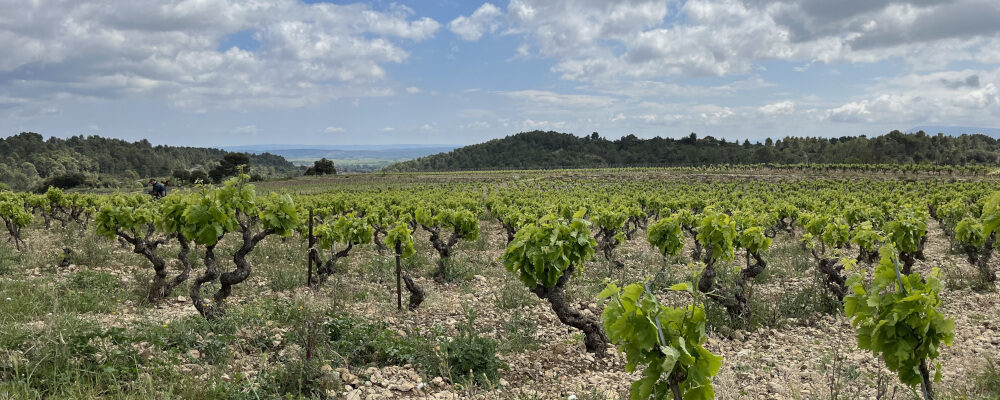A few hundred metres up the hill from Château Sainte Eulalie, on a dirt and gravel track through the stony vineyards it hit us. We were a handful of international wine journalists, who after a tasting featuring a handful of local wine producers at the Château, were out to see the vines and the countryside. ‘It’ was a subtle and persistent smell coming from the direction of our shoes: garrigue!
There were weeds in the median and on the sides of the track, and as we were trudging though and on them, they released an aroma of wild herbs, mostly thyme. Red wines from the South of France are said often to mimic the smells from the wild plants that inhabit the scrubby pine hills their vines are grown on. We’d smelled and tasted garrigue before in the glass, but it was thrilling to sense it right in the place.
Madame Isabelle Coustal, our host and guide, gave a friendly Gallic shrug when we explained why we had stopped, as if to say, “Of course there’s garrigue.” Looking back downhill we could see the square Romanesque bell tower of the church in Lalivière, a picturesque ancient village whose name comes from the word for vines in the old Occitanie language. This was Languedoc.
Languedoc once nearly made half of all the wine in France and still makes about a quarter. Had there been an actual location of the metaphorical European Union Wine Lake, during the early part of this century, it would have been in Languedoc, somewhere west of the Rhône River, east of the Cobière Mountains and north of the Mediterranean Sea.
Some of France’s biggest export brands come from Languedoc AOP, though they will often carry the less site specific appellation of the region, Pays d’Oc IGP. Languedoc is a good place to make wine and has been making a lot of it for a long time. The Roman Emperor Domitian (81-96 CE) declared an edict limiting the import of the wines to the city from what is now Languedoc.
But the point of the visit to Château Sainte-Eulalie, and the walk through the vineyards of the property and its neighbours was to show my colleagues and me how Languedoc can also be small. Sainte-Eulalie is in the heart of Minervois La Livinière, one of Languedoc’s five Village Designated Appellations along with La Clape, Corbières Boutenac, Fitou and Faugères.
As there names suggest, La Livinière and Boutenac are carved out of larger appellations within Languedoc, Minervois and Corbières, respectively. La Clape is also found within the large Corbières appellation. Faugères and Fitou are their own appellations in their own right, with an eponymously named village in their centre. Looking at a map, the five village designations are more or less evenly spread over the western end of Languedoc.
Appellations and designations in France are ruled by what’s known as a Cahier des Charges, or CDC. This is a kind of constitution, whose rules are decided by the governing body of the organization of the producers who make wine under the appellation. If you are in the geographic boundaries of the appellation (which can change), then you may label your wine with the appellation’s name if, and only if, you follow the edicts of the CDC.
The framers of a given CDC tend not to be originalists. The rules are often tweaked and adjusted, especially to suit anticipated market demand. Fights over the content of the rules are common. Every appellation will have black sheep who prefer to do their own thing and make wine, or some of their wine, outside of the rules. Notwithstanding dissent, the CDC is meant to guarantee the quality of the wine of the particular place in a way that consumers can recognize.
The key to the differences between the five Languedoc Village Designated Appellations is their “encépagement,” a wonderfully unique French word. Encépagement, which is laid out in the CDC, refers to the grape varieties allowed to be used in the appellation wine and at what percentages. For the red wines of the Languedoc Villages, this mostly means the amount of Grenache (Noire), Syrah, Mourvèdre, or Carignan allowed in the blend.
Since I am paid by the word, it is tempting to enumerate the various encépagement requirements of the five villages. However, my editors have placed me under a strict word count, I am afraid there wouldn’t be much room left in this column for anything else. Suffice to say, they are complicated, and list a number of permutations and combinations of primary and secondary grapes, often with both a floor and a ceiling percentage of what can be used for each, as well as specifications of how much particular blends can be allowed per bottle.
The main purpose of the Village CDC’s seems to be to limit the amount of Carignan in the blends. Carignan was once the most planted vine in Languedoc. It was the workhorse grape, prized for it’s vitality and high yield. A field of Carignan could make a lot of not-especially flavourful wine, which was fine for farmers who were used to getting paid by a co-operative by volume and weight.

When efforts to reduce the Wine Lake began in the last decades of the 20th century, the vines the farmers pulled out first were Carignan, and when they replanted, if they stuck to the traditional grape varieties of the South of France, it would more like be fashionable Syrah, perhaps in hopes of establishing a western version of the Côtes Rotie.
The vignerons of Corbières Boutenac, often labeled simply a Boutenac, seem to have bucked this trend. They realized that old vine Carignan can make deeply dark and complex wines. Now, of course, all Carignan is likely to be more than thirty years old, so they decided the Boutenac wines would have a floor requirement of 30 percent Carignan. Even still, the Boutenac CDC won’t allow more than 50 percent Carignan in their blends, which are rounded out with Grenache and Mourvèdre, and maybe a little Syrah, depending on the producer.
Alternatively, in La Clape they celebrate Mourvèdre, but not too much and always with Syrah and Grenache. And so it goes, the wines are always a blend, Grenache (for fruit) and Syrah (for spice) will be there, and maybe Carignan, Mourvèdre, possibly Cinsault. Within the confines of the CDC, the vigneron will decide on a blend based on what they have to work with and what expresses their idea of the Village best.
The Languedoc Villages wines are worth looking for. They’ll have the name of the village somewhere on the front label. These wines are often at the higher level of bigger producers (like an “Estate Reserve”), or the product of a small, artisan winery. This is to say they are not cheap and will generally retail for $30 and up. More often worth it if you’re looking for quick escape into the garrigue of the South of France.




